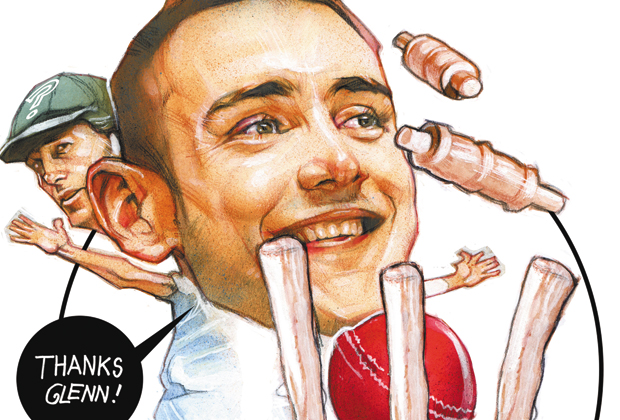At the risk of rubbing it in, the mood of those Aussie supporters who conferred the status of the Pantomime Villain Pom on Stuart Broad for not walking in the first Test at Trent Bridge may not be improved by the understanding that England’s three-time Ashes winner owes most of his career to Glenn McGrath, if not all of it.
Watching him plan, craft and deliver the most inch-perfect ball he will ever bowl to dismiss Michael Clarke on that frenetic final day in Chester-le-Street, then complete his one-man annihilation of Australia’s hopes of victory, and a drawn series, in a game-changing spell even more crushing than the one he produced against them at The Oval in 2009, raised a memory of a conversation that took place five and a half years ago, in March 2008, when the then 21-year old had just three Tests and nine Test wickets to his name.
Coach Peter Moores and captain Michael Vaughan had risked much when, reacting to defeat in the first Test against New Zealand in Hamilton, they picked Broad and James Anderson in place of Steve Harmison and Matthew Hoggard, two of the giants of England’s 2005 Ashes victory and their first for 18 long years.
But their attempt to demonstrate nobody was indispensible had paid off with wins in Wellington and Napier, where the tall Nottinghamshire bowler had contributed five wickets to help clinch the series 2-1, plus 42 and 31 not out at No.8.
While most attention had settled on a brave century by Andrew Strauss that probably saved his Test career, on the balcony of his hotel room looking out towards Hawke’s Bay, Broad’s revelation about the inspiration he had drawn from McGrath, Australia’s highest wicket-talking paceman, was as touching as it was unexpected, particularly when he came to the bit about placing a photo of the old metronome himself on his bedroom wall and why he did it, namely for giving a frustrated teenager a reason to believe in himself when he needed it most.
“I read this article about Glenn in the Wisden Cricketer magazine when I was about 18,” he explained, “and it had a big effect on me.
“Glenn said that when he was a teenager he could barely get a game for his club at home in Narrowmine because his captain didn’t think he could bowl and it wasn’t until the skipper stopped playing that he got his chance.
“The thing is… he sounded just like me.
“As a kid I loved bowling, but Leicestershire didn’t really think I could bowl and they played me as a batsman only in county age group cricket.
“I was desperate for a chance to show what I could do with the ball, but they didn’t rate me and it never came.
“I found it incredibly frustrating because I knew that I was going to have to start bowling soon if I was going to kick on. I used to moan about it to my mum all the time.
“So when I saw that interview in the magazine and read that the great Glenn McGrath had suffered the same experience I stuck the piece on my bedroom wall as motivation and resolved not to give up, but to keep working on my bowling for as long as it took for it to be taken seriously.
“I drew a lot from Glenn’s story and his example.”
What Broad showed once again in Durham is just how lethal he can be when he bowls like him as well.
McGrath’s great strength was his ability to land the ball precisely where he wanted, almost without fail, so that, if you removed the batsmen from the scene, he was capable of hitting the top of off stump from a good length on average five out of six times per over.
Allowing the ball that full length and presenting an upright seam meant the ball might then go either way off the seam, as it did unplayably against England on numerous occasions but never more damagingly than in the first Test of 2005 at Lord’s after which Marcus Trescothick memorably suggested: “He bowled like God.”
Keeping the bouncer as a surprise weapon meant batsmen could never feel entirely comfortable on the front foot.
No jumping the gun intended, but for all of the above read Stuart Broad against Clarke at the Riverside, and there’s more. While McGrath was not renowned for conventional or reverse swing, Broad can offer both and if the man who took 563 Test wickets took one of them with a ball as quick as the 90mph-plus killer delivery that pitched on the Aussie skipper’s off stump and bent it backwards, it would have been time to adjust the speedgun.
All of which explains the phenomenon known as a Broad hot-streak, in which one wicket becomes two, or three in the case of his hat-trick against India’s MS Dhoni, Harbhajan Singh and Praveen
Kumar two summers ago at Trent Bridge, because, when everything clicks, a new batsman simply has no place to hide.
And here’s a reminder of how; four years ago he was on the verge of being dropped from the 2009 series after poor showings in the first two Tests which he felt might have been down to trying to be too aggressive.
On the square at Edgbaston and under the eye of bowling coach Ottis Gibson he placed a cone 16 feet from the stumps, his natural full length, and bowled within himself, concentrating on hitting it every time. And he continued to do exactly the same in every warm up session for the rest of that summer.
“It’s not what about the ball does,” Gibson nudged him, “but where it does it from.” It was surely no coincidence that, thereafter, having taken four wickets for 307 @ 76.75, he proceeded to collect 14 for 237 @ 16.92.
Nor was it at Durham on Monday, when he pitched a fuller length and let the ball do the work to take 6-20 in 45 balls, just like a certain Aussie legend whose example encouraged him to keep going when very few believed it was worth the effort.












